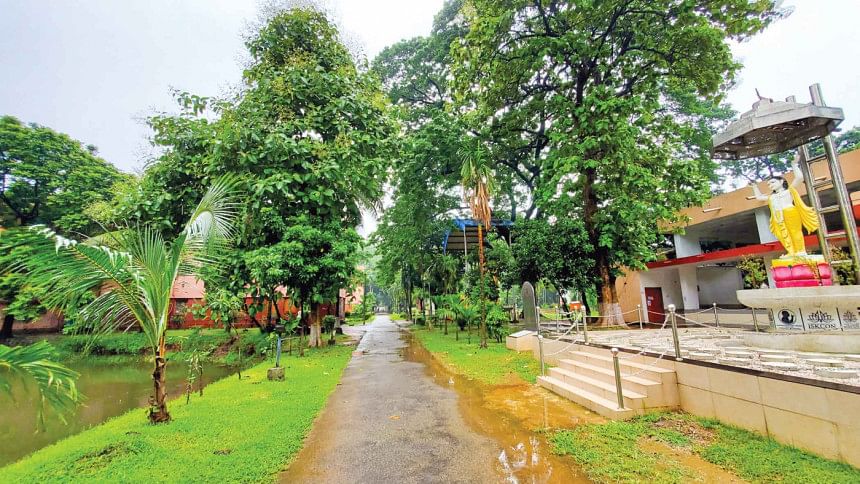Dhaka University Campus: Green in the urban jungle

If the pandemic lockdowns make you feel trapped and you feel like visiting some place within Dhaka, the University campus is a safe bet. You would be hard pressed to find such a wonderful environment inside the city. The University is closed now, so the area is peaceful and quiet. The krishnochura trees are in full bloom, the roadsides shrubs are covered in different flowers as well. The jarul flower's purple colour brightens up the surroundings. The tall banyans, jackfruit, and hijal trees bring coolness to the hot summer days.

From the well-known environs of the Shaheed Minar, leaving behind Salimullah Hall, you could go to the Arts Faculty. Right in front of the main gate, there is a large old banyan tree, with the base surrounded by an elevated platform. A perfect place to sit and chat while the little ones in the group run around and play: a perfect opportunity to introduce children to nature.
The rows of trees in the large ground in front of the Registrar building have grown some more in this year and a half, creating a lot of shade and breeze there. Although the student-favourite fuchkawala and jhalmuriwalas are not there at the moment, but small ice cream vans, green coconut peddlers, and perhaps peanut sellers might be there. As very few cars go there at the moment, there is practically no noise, rather a lot of birdsong. You will suddenly catch a whiff of a sweet fragrance, and on looking about, will find a hasnahena or kamini in bloom nearby, and the Aparajeyo Bangla standing proud right ahead.
Those who studied at this university know well, but so do others. The history of this university is resplendent with memories of happiness, grief, struggles, festivals et al. On days of national or cultural significance like Victory Day, Pahela Baishakh, Ekushey February, the campus is crowded with students and visitors. But you can enjoy a relatively peaceful and fun visit on holidays and during the afternoons, even when the university is open for classes. The entire Hakim Chattar, library area, cafeteria is all abuzz with youngsters spending time.
The way you can enjoy Hakim Chattar now would not be possible when classes are ongoing, as the chatter and footfall of hundreds of students from not only the Arts Faculty but all other departments as well as those of BUET and the nearby Dhaka Medical College changes the atmosphere here completely.
A little further ahead lies TSC. Although the entrance to the actual building remains close, the enclosure outside has people hanging about— the tea sellers with their various flavours of tea, and of course the jhalmuri and bootwalas. It is a good time to take some pictures in front of it, as this building, along with the millions of memories it houses, has been earmarked for demolition and replacement with a multi-storey one.

Our time in Dhaka university, around 1985-1990, was a politically active one. The movement against Ershad's military dictatorship was going strong, and the centre for all resistance was this TSC, standing for the Teacher Student Centre. It is more popularly known by its acronym, and not just by students and teachers, but all strata of general people as well.
TSC was not the centre of resistance for the movement against Ershad, with cultural resistance through songs, poetry, dance and drama, but also played a similarly significant role during the Liberation War, as well as all other movements of national importance. It remains a cultural hub, and still houses the offices of university's photography club, tourist society, chess club, Rover Scouts, blood bank, etc.
The TSC was built in 1961 so that teachers and students could come together to not only study but also to socialise and interact, for community building. The building, with its well-known dome, was designed by architect Constantinos Apostolos Doxiadis.
Within the TSC compound, amidst the green field, stands a small Greek mausoleum, dating back to 1915, built in the Doric tradition of Greek architecture. It is a witness to the few Greek families that lived in Dhaka in the 19th century. It's a good idea to visit, and to show your children, as it will be demolished as well in a few days.
My father used to commute through the campus often. Every time we saw the Aparajeyo Bangla sculpture, he felt alive. It was the same for us too. The campus was all-present in our sub-conscious, be it for hangouts, fun, journalism, debate, anti-Ershad resistance, the Ekushey book fair. These were a big part of our university life.
When general people of the country thought of the campus area as being dangerous, given the reports of rallies, processions, and violent shootings, we still felt it was the safest place for us. So we return here often, roaming around under the shade of the tall green trees, and so, you are welcome to it too. But fair warning, better leave the area before dark.

Translated by Sania Aiman
Photo: Sazzad Ibne Sayed

 For all latest news, follow The Daily Star's Google News channel.
For all latest news, follow The Daily Star's Google News channel. 



Comments